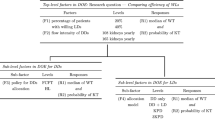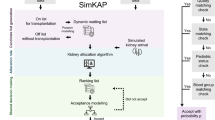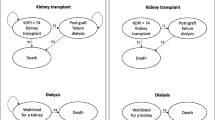Abstract
A shortage of donor liver grafts unfortunately results in approximately 10% of patients dying whilst listed for a liver transplant in Europe and the United States. Thus it is imperative that all available organs are used as efficiently as possible. This paper reports upon the application of a simulation modelling approach to assess the impact of several alternative allocation policies upon the cost effectiveness of this technology at one liver transplant centre in the UK. The impact of changes in allocation criteria on the estimated net life expectancy, average net costs and overall cost effectiveness of the transplantation programme were evaluated. The incremental cost effectiveness ratio (ICER) for the base case allocation policy, based upon the time spent on the waiting list (i.e., longest wait first) was £11,557 at 1999 prices. The ICERs associated with an allocation policy based upon age (lowest age first), and an allocation policy based upon the severity of the pre-transplant condition of the patient (with most severely ill patients given a lower priority) were lower than the base case at £10,424 and £9077, respectively. The results of this modelling study suggest that the overall cost effectiveness of the liver transplantation programme could be improved if the current allocation policy were modified to give more weight to the age of the patient and the reduced chances of success of the most severely ill patients.
Similar content being viewed by others
REFERENCES
UNOS, 1998 Annual Report of the US Scientific Registry for Transplant Recipients and the OrganProcurement and Transplantation Network: Transplant Data: 1988–1997, UNOS, Richmond, VA, USA (1998).
UKTSSA, Liver Transplant Audit 1985–1995, United Kingdom Transplant Support Services Authority, Bristol, UK(1995).
A. Pritsker, J.R. Wilson, M.D. Allen et al., Organ transplantation policy evaluation, in: Proceedings ofthe 1995 Winter Simulation Conference.
J. Neuberger, Allocating donor livers, British Medical Journal 314(1997) 1140–1141.
O. Jonasson, Waiting in line: should selected patients ever be moved up?, Transplantationproceedings 21 (1989) 3390–3394.
J.W. Williams, S. Vera and L.S. Evans, Socio-economic aspects ofhepatic transplantation, American Journal of Gastroenterology 82 (1987) 1115–1119.
J. Showstack, P.P. Katz, J.R. Lake et al., Resource utilization in liver transplantation: effect of patient characteristics and clinical practice, Journal of the American Medical Association 281 (1999) 1381–1386.
A. Pritsker, Life and deathdecisions, OR/MS Today (August 1998) 23–28.
J.R. Beck and S.G. Pauker, TheMarkov process inmedical prognosis, Medical Decision Making 3 (1983) 419–458.
R.W. Klein, R.S. Dittus, S.D. Robertsand J.R. Wilson, Simulation modelling and health care decision making, Medical Decision Making 13 (1993) 347–354.
J. O'Grady and R. Williams, Selection for transplantation, Journal of Hepatology 19 (1993)485–486.
M.D. Hughes, C.L. Raskino, S.J. Pocock et al., Prediction of short term survival with an application inprimary biliary cirrhosis, Statistics in Medicine 11 (1991) 1731–1745.
A.C. Anand, B.H. Ferraz Neto, P. Nightingale et al., Liver transplantation for alcoholic liver disease: evaluation of a selection protocol, Hepatology 25 (1997) 1478–1484.
E.R. Dickson, P.M. Grambsch, T.R. Fleming et al., Prognosis in primary biliary cirrhosis:model for decision making, Hepatology 10 (1989) 1–7.
Visual Thinking International,SIMUL8, Williamstown, MA, USA.
J. Ratcliffe, Public preferences for the allocation of donor liver grafts fortransplantation, Health Economics 9 (2000) 137–148.
Author information
Authors and Affiliations
Rights and permissions
About this article
Cite this article
Ratcliffe, J., Young, T., Buxton, M. et al. A Simulation Modelling Approach to Evaluating Alternative Policies for the Management of the Waiting List for Liver Transplantation. Health Care Management Science 4, 117–124 (2001). https://doi.org/10.1023/A:1011405610919
Issue Date:
DOI: https://doi.org/10.1023/A:1011405610919




